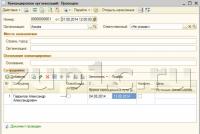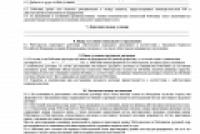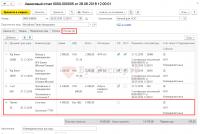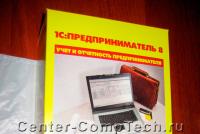Balance sheet completed sample sample. The procedure for drawing up the balance sheet (example). Section I. Non-current assets
Example conditions
Vympel LLC, registered in 2015, produces furniture (main activity), as well as wholesale trade in purchased goods. Organization details are given in table. 1. Data for filling balance sheet for 2015 - in the following table. 2.
Table 1. General information about LLC "Vympel"
Table 2. Balances in the accounting accounts of Vympel LLC as of December 31, 2015
Account, sub-account |
Balance as of 31.12.2015, RUB |
|
|---|---|---|
|
debit |
credit |
|
|
01 "Fixed assets" |
||
|
02 "Depreciation of fixed assets" |
||
|
04 "Intangible assets" |
||
|
05 "Amortization of intangible assets" |
||
|
08 "Investments in non-current assets" |
||
|
09 "Deferred tax assets" |
||
|
10 "Materials" |
||
|
20 "Main production" |
||
|
41 "Products" |
||
|
43 "Finished products" |
||
|
50 "Cashier" |
||
|
51 "Settlement accounts" |
||
|
58 "Financial investments", 58 subaccount "Provided loans" (loan repayment period exceeds 12 months) |
||
|
60 "Settlements with suppliers and contractors", 60 subaccount "Settlements for purchased goods, services" (short-term debt) |
||
|
60 "Settlements with suppliers and contractors", 60 subaccount "Advances issued" (short-term debt) |
||
|
62 "Settlements with buyers and customers", 62 subaccount "Settlements on the sold goods and materials" (short-term debt) |
||
|
62 "Settlements with buyers and customers", 62 subaccount "Advances received" (short-term debt) |
||
|
68 "Calculations of taxes and fees" (short-term debt) |
||
|
69 "Payments for social and security" (short-term debt) |
||
|
70 "Payments to staff on remuneration" (short-term debt) |
||
|
71 "Settlements with accountable persons" (short-term debt) |
||
|
76 "Settlements with other debtors and creditors", 76 subaccount "Provided interest-free loan" (long-term debt) |
||
|
77 "Deferred tax liabilities" |
||
|
80 "Authorized capital" |
||
|
82 "Reserve capital" |
||
|
84 "Retained earnings (uncovered loss)" |
||
An example of filling out an asset balance sheet
Let's comment on the filling of individual lines in the balance sheet asset.
The indicator of line 1110 "Intangible assets" is determined as follows: the balance of account 05 is deducted from the debit balance of account 04. In total, we obtain the residual value of intangible assets in the amount of 56,000 rubles. (80,000 rubles - 24,000 rubles).
The indicator of line 1150 "Fixed assets" is calculated as follows: debit balance of account 01 - credit balance of account 02. Result - residual value of fixed assets in the amount of 768,900 rubles. (1,000,000 rubles - 231,100 rubles).
The indicator of line 1190 "Other non-current assets" is construction in progress (account 08) and an interest-free loan, which is a long-term receivable (account 76). The total amount is 113,500 rubles. (RUB 68,500 + RUB 45,000).
The indicator of line 1210 "Inventories" includes balances by materials (account 10), costs in work in progress (account 20), the cost of goods for resale (account 41), and finished products (account 43). The total figure is 292,760 rubles. (58 900 rubles + 38 660 rubles + 137 000 rubles + 58 200 rubles).
The indicator of line 1230 "Accounts receivable" consists of the debit balances of accounting accounts in the part of short-term debt and is equal to 493 344 rubles. (34 090 rubles + 457 834 rubles + 1420 rubles).
The indicator of line 1250 “Cash and cash equivalents” was found by adding the debit balance of accounts 50 and 51. The result is 1,122,767 rubles. (RUB 1,390 + RUB 1,121,377).
An example of filling out the liability of the balance sheet
For the balance sheet liability it is required to calculate the indicator of line 1520 "Accounts payable". It is made up of credit balances of accounts for accounting settlements in terms of short-term debt and is equal to 2,552,863.80 rubles. (2 111 110 rubles + 210 900 rubles + 16 104.80 rubles + 27 835 rubles + 186 914 rubles).
The rest of the calculation indicators do not require and are simply posted to the corresponding balance sheet items.
A sample of filling out the balance sheet for the considered example, see below.
Have a question? Our experts will help you in 24 hours! Get New
We pointed out that the balance sheet is the most important form of reporting, and also provided the structure of the balance sheet in a separate one. Despite the fact that drawing up a balance sheet in the context of automation of accounting work is a matter of technique, it is extremely important to know how to fill out a balance sheet. This will allow not only to identify possible errors and inaccuracies in drawing up the form, but also to correctly “read” the balance and analyze its indicators. We will remind you of the procedure for drawing up the balance sheet in our consultation, and also show how to fill out the balance sheet using an example.
How to draw up a balance?
Drawing up the balance sheet is the final stage of accounting work. And it can be correctly compiled only on the basis of complete and reliable data contained in the accounting system. Such data is collected in. The data of these registers and their transcripts is an information base when drawing up reports, incl. and balance sheet.
When preparing the balance sheet, it is important not only to know the procedure for maintaining accounting records and reflecting transactions on accounts, but also to remember the basic rules that are specific to compiling accounting statements.
For example, in the balance sheet, assets and liabilities should be divided into short-term and long-term (clause 19 of PBU 4/99). Assets and liabilities are considered short-term if their circulation (maturity) period does not exceed 12 months after the reporting date or the operating cycle if it is more than 12 months. And all other assets and liabilities are presented in the balance sheet as long-term. That is why fixed assets are reflected in the balance sheet in section I " Fixed assets", And goods - in section II" Current assets ".
Features of drawing up a balance
In the balance sheet, it is not possible to offset between the items of assets and liabilities, unless such offset is provided for by the relevant accounting provisions. This means, for example, that if there is reporting date accounts receivable of buyers in the amount of 120,000 rubles and payables to personnel for remuneration of 80,000 rubles in the balance sheet, these indicators should be reflected separately - 120,000 rubles - in assets, and 80,000 rubles - in liabilities. It is impossible to show only the difference of 40,000 rubles (120,000 rubles - 80,000 rubles) in the balance sheet asset. However, VAT on the advance received or issued reduces the amount of accounts payable and receivable, reflected in the balance sheet, respectively (Letter of the Ministry of Finance dated 09.01.2013 No. 07-02-18 / 01).
It is also important to remember that in the balance sheet the indicators are reflected in the net assessment, that is, minus the regulatory values \u200b\u200b(clause 35 of PBU 4/99). This means, for example, that fixed assets in the balance sheet are shown at their residual value (i.e., excluding depreciation), and customer accounts are shown minus the allowance for doubtful debts.
Let us also recall that in the balance sheet, data must be provided for at least 2 years - reporting and preceding the reporting (paragraph 10 of PBU 4/99). At the same time, in the form of a balance sheet, approved by Order of the Ministry of Finance dated 02.07.2010 No. 66n, the data are reflected as of the reporting date, December 31 of the previous year and December 31 of the year preceding the previous one.
Filling out the balance sheet: an example with a breakdown
To compile or check the prepared balance sheet, they usually use such an accounting register as the balance sheet. But you only need to take from it the indicators of the balance, that is, the balance, because the balance discloses data on a specific date, and not for a period. Along with the balance sheet, transcripts to accounts and other analytical data are used as necessary.
How to make a balance sheet using an example with step by step instructions we will show below.
Let's give an example of the balance sheet of Zima LLC as of 12/31/2017. For simplicity, let's say the organization was created in 2017. Therefore, there will be no comparative reporting indicators as of 31.12.2016 and 31.12.2015 in the balance sheet. Considering that the data on assets and liabilities in the balance sheet, in the general case, are not subject to offset, the balance sheet must be presented in an expanded form. This means that both debit and credit balances will be reflected on active-passive accounts.
You can view the balance sheet for 2017.
To fill in the balance sheet, we will provide a breakdown for individual accounting accounts. It should be noted that the balance on accounts 60 "Settlements with suppliers and contractors" and 62 "Settlements with buyers and customers" consists exclusively of short-term obligations.
The credit balance of account 62 represents an advance received in the amount of 177,000 rubles, from which VAT was charged in the amount of 27,000 rubles (177,000 * 18/118) and is reflected in the accounting entry: Account 76 debit "Settlements with different debtors and creditors" - Credit account 68 "Calculations of taxes and fees".
The balance of account 97 represents expenses on the software products used (non-exclusive rights) of a long-term nature.
We will give for each line of the balance sheet in the order of reflection of the existing balance in the balance sheet.
The balance completed based on the above example can be downloaded from the link below.
Download in excel quickly and free of charge the current form of the balance sheet and the completed sample 2016. What do you need not to forget when filling out the balance sheet of the company? The most important thing in the preparation of the main accounting report of the organization.
The balance sheet is one of the forms of financial statements that must be submitted to tax authority and the statistics body. With the help of this report (it is also called Form 1), organizations report on their assets and liabilities, distributing their accounting data between balance sheet items.
The balance is returned at the end of the calendar year. In particular, in 2016 it is necessary to fill in the balance sheet for 2015 and bring the accounting data of the enterprise on the last day tax period (31th of December).
The current form was approved by Order of the Ministry of Finance dated 02.07.2010 No. 66n (as amended by Orders of the Ministry of Finance of Russia dated 17.08.2012 No. 113n, dated 06.04.2015 No. 57n). You can download the balance sheet and sample filling for 2015 at the bottom of the article. Links are provided for download for free. Document format - excel.
The balance sheet for 2015 must be submitted within the first three months of 2016, that is, the deadline for submitting Form 1 is March 31, 2016.
Small business balance sheet can be downloaded.
The balance can be submitted to the tax office in any convenient form (on paper or electronically). It is allowed to send a report by registered mail with a list of attachments. An additional copy of the completed Form 1 should be sent to Rosstat, where the organization is registered.
The balance sheet is submitted together with a statement of financial results, which is also a mandatory component of the company's annual financial statements. It is also necessary to fill out and submit a report on changes in capital and movement money... Links for filling out these documents are presented below.
Sample filling
When filling out the balance sheet for 2015, you should provide data for three years - reporting and two previous ones. Information is indicated on the basis of the balance sheet as of December 31, 2015, information for previous years should be taken from the balance sheet for the previous year.
The report contains two sections, the first one reflects all the assets of the organization with a breakdown by item (depending on the type of asset); the second reflects all the liabilities of the organization, which are also distributed by line item.
Liabilities form assets, are sources of their financing, therefore the sum of all assets must be equal to the sum of all liabilities.
The total amount of assets is displayed in the last line of the "assets" section, this amount consists of the total value of non-current and current assets. Non-current assets include all those assets whose life exceeds one year (fixed assets, intangible assets, capital investments, exploration assets, long-term financial investments for a period of more than one year, and others). Current assets include those with a period of use less than 1 year (inventories, raw materials, goods, receivables, VAT, cash and their equivalents, financial investments for a period of less than one year).
The total amount of liabilities is displayed in the last line of the "liabilities" section, this amount consists of the total cost of the organization's equity capital and its reserves, long-term and short-term liabilities (loans, accounts payable, borrowed funds, etc.).
The balance sheet form for 2014 was approved by the Order of the Ministry of Finance of Russia dated 02.07.2010 No. 66n (as amended on 04.12.12), the form itself is in Appendix No. 1 to this order.
A completed sample balance sheet, which must be submitted in 2015 for 2014, can be downloaded at the end of the article. This report for 2014 must be submitted by March 31, 2015.
The form is optional and can be changed by the organization at its discretion. All organizations in any tax regime must fill out the balance sheet for 2014. If the enterprise belongs to small businesses, then it is allowed to fill out a simplified balance sheet form.
Together with the balance sheet, you must also fill out and submit a statement of financial results (form 2), a statement of changes in equity (form 3) and a cash flow statement (form 4).
Video lesson "Balance sheet of the organization: maintenance"
In the video lesson, the expert practitioner of the site “Accounting for Dummies” Natalya Vasilievna Gandeva explains with examples how to maintain a balance sheet in an organization.
1370 - behind reporting year (retained earnings, uncovered loss) (account balance 84).
1300 - the total amounts for the third section of the balance sheet.
Completing the balance sheet section: Long-term liabilities
1410 - debts on loans and borrowings for a period of more than one year (account 67).
1420 - deferred income tax (account 77).
1430 - estimated liabilities for more than one year (account 96).
1450 - other long-term liabilities of the organization (that is, those liabilities whose maturity exceeds 12 months).
1400 - the sum of all lines of this section of the balance sheet.
Completing the balance sheet section: Short-term liabilities
1510 - loans and borrowings taken for a period of less than 1 year (account 66) and long-term loans converted to short-term loans (account 67).
1520 - the organization's debt for a period of less than 12 months to customers, suppliers, personnel (accounts 60, 62, 68, 69, 70, 71, 73, 75, 76).
1530 - deferred income (account 98).
1540 - estimated liabilities for a period of less than one year (account 96).
1550 - other short-term liabilities of the organization (that is, those liabilities with a maturity of less than 12 months).
1500 - the sum of all lines in the section.
1700 - the sum of lines 1300, 1400 and 1500.
The numbers indicated on line 1600 must match the numbers indicated on line 1700.
The coincidence of these numbers will mean that the balance sheet is filled in correctly.
At the end of each reporting period filling out the balance sheet for small businesses has its own characteristics, since it is shorter than the standard form of this report and includes mainly generalized accounting indicators. In our consultation, we will tell you how to correctly perceive and fill out certain lines of it.
General requirements
In most cases filling out the balance sheet for a small business goes on a simplified form, which was approved by order of the Ministry of Finance of Russia dated July 02, 2010 No. 66n.
If a small company has been operating for several years and is not submitting an annual report for the first time, then any sample balance filling for small businesses implies the indication on each line of the amount:
- as of the reporting date of the reporting period (i.e. 31.12.2016);
- as of December 31, 2015;
- as of December 31, 2014.
Thus, information and amounts for the period of 2015 should be taken from last year's reports. And to fill out a simplified balance sheet for small businesses indicators for 2016, you need:
- balance sheet for all accounts for 2016;
- an extract on the interest accrued for the 2016th year on the loans and borrowings received by the company (CT account 66 "Short-term loans and borrowings" and account 91 "Other income and expenses").
You can often find example of filling out a balance sheet for a small businesswhere there are blank lines with dashes. Is this acceptable? Quite. Indeed, the balance sheet does not always have the appropriate data to fill in individual balance lines. And in this case, the accounting rules are allowed to put down dashes. The basis is paragraph 11 of PBU 4/99.
Then how to fill in the balance for small businesseswho designed his own letterhead? The answer is simple: if you do not work with a typical balance sheet form, then do not provide the missing indicators.
Codes to the lines of the balance sheet of a small enterprise are assigned according to the table from Appendix No. 4 of the order of the Ministry of Finance No. 66n. In this case, the principle must be observed: according to the aggregated indicators, they take the code based on the indicator that has the greatest specific weight in it.
Also, do not forget to put dashes in the remaining empty cells of the lines. This approach to a sample of filling the balance sheet for small businesses for 2016 the year will allow not to make mistakes or unnecessary additions, which will inevitably affect the result of the report.
Shown below sample of filling out the balance sheet for small businesseswhich should be followed when entering amounts for each line:

How to fill in lines
Now about what is the procedure for filling the balance sheet for small businesses for specific lines. Here you need to know the rules of the basic PBU, with which the activities of small businesses usually intersect.

Balance asset
| Line | How to count |
|---|---|
| Tangible non-current assets | Use the formula: SALDO 07 "Equipment for installation" |
| Intangible financial and other non-current assets | Fill in only if there is a balance of at least one account: 04 "intangible assets"; When there are balances on them, indicate the amount for intangible assets and long-term financial investments. It is determined according to the rules of extended reporting. |
| Stocks | Use the formula: SALDO 10 "Materials" Please note: this formula does not apply if the firm also uses other accounts to account for costs and inventories. Then the indicator is determined according to the rules of extended reporting. |
| Cash and cash equivalents | Use the formula: SALDO 50 "Cashier" |
| Financial and other current assets | Use the formula: Dt SALDO of all sub-accounts to accounts (62 + 60 + 68 + 69 + 70 + 71 + 73 + 75 + 76) If there are balances on account 58, the indicator of this line must be increased by the size of short-term financial investments (according to the rules for extended reporting). |






